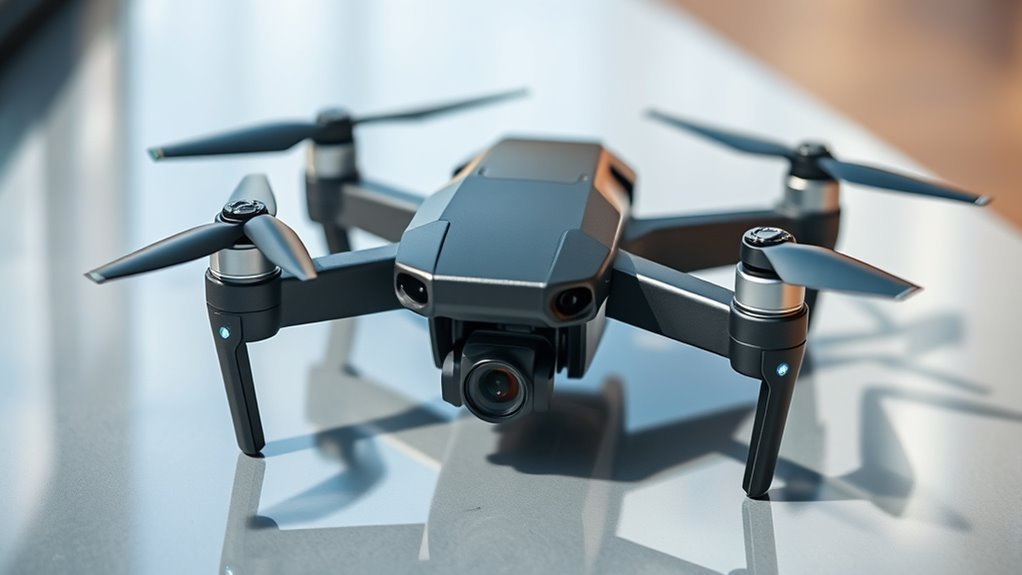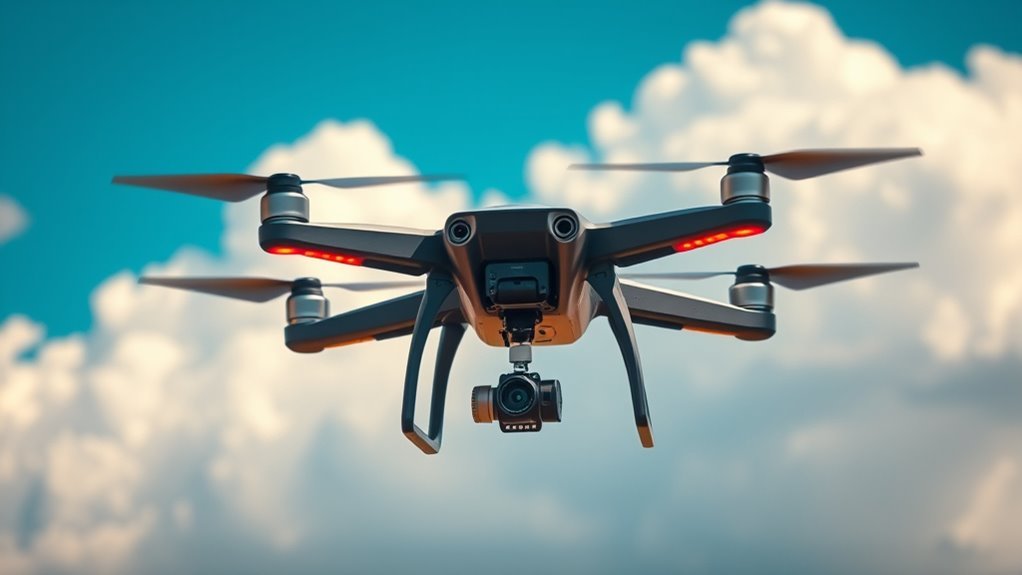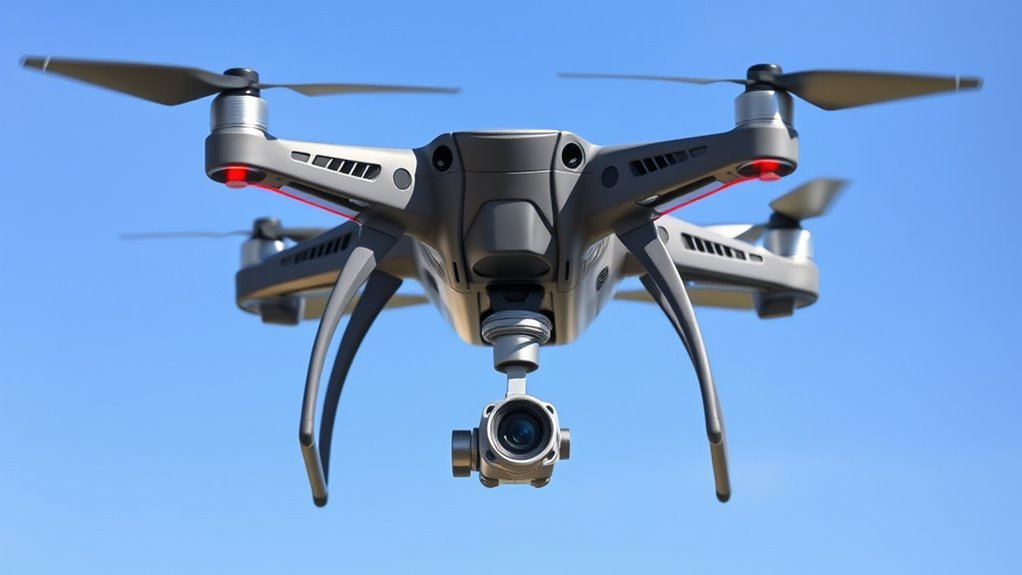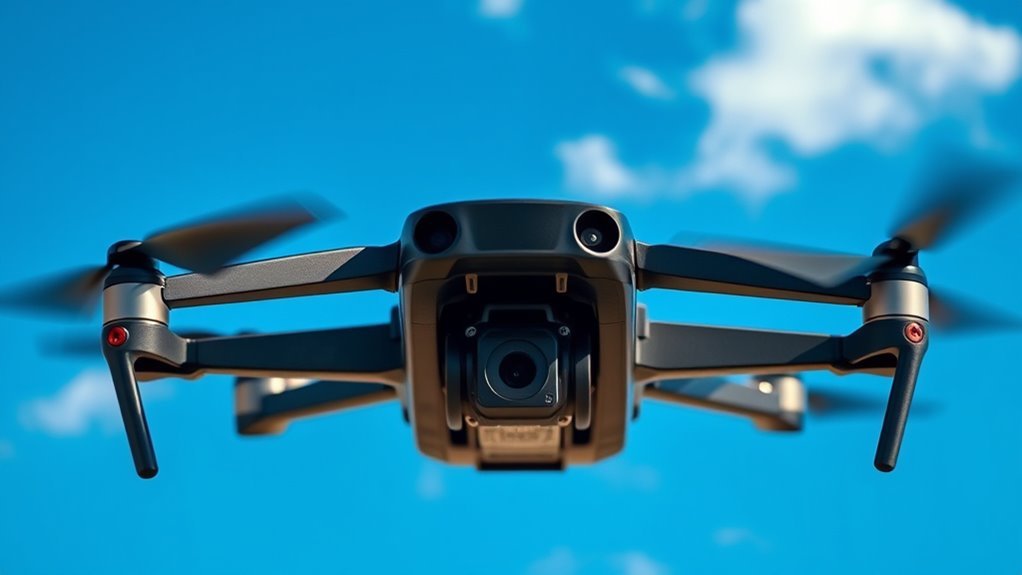When identifying a drone, focus on key features like flight time, camera quality, range, build durability, and intelligent flight modes. Evaluate battery life and management systems for ideal flight duration. Examine the camera specifications and stabilization technology for clarity in imaging. Check the effective operational range and control distance. Assess material quality for durability against impacts. Finally, consider advanced features like obstacle avoidance for enhanced safety. There’s much more to explore on these critical aspects.
Flight Time and Battery Life

When considering drones, one of the most critical specifications you’ll encounter is flight time, often closely tied to battery life. Advanced battery technology plays a pivotal role in determining how long your drone can stay airborne. Lithium-polymer (LiPo) batteries are commonly used due to their high energy density and lightweight characteristics. However, it’s not just the battery itself; effective power management systems also greatly influence flight duration. By optimizing energy distribution during flight, drones can maximize efficiency and extend operational time. You’ll want to assess both the battery capacity, measured in milliamp-hours (mAh), and the drone’s power consumption. Understanding these factors guarantees you’ll achieve the freedom to explore the skies without frequent interruptions for recharging. Notably, the flight time metrics of drones like the Anzu Raptor T can extend up to 45 minutes, showcasing the advancements in battery efficiency. Additionally, the Freefly Astro Prime offers up to 25 minutes of flight time, demonstrating the significance of battery performance in outdoor applications.
Camera Quality and Stabilization

Flight time and battery life are significant, but the quality of the camera on your drone can dramatically enhance your aerial experience. When evaluating camera capabilities, focus on lens specifications, including aperture size and focal length, as these factors influence light intake and depth of field. Higher resolution sensors provide sharper images, while advanced image processing algorithms improve color accuracy and reduce noise, especially in low light conditions. Stabilization features, such as 3-axis gimbals, play an essential role in ensuring smooth footage, counteracting wind disturbances and drone movements. By prioritizing these elements, you can achieve stunning aerial photography and videography, allowing you to capture your adventures with precision and artistic freedom. Additionally, opting for drones that support 5.1K video resolution can elevate your visual storytelling with unmatched detail and clarity. The advanced stabilization technology found in models like the DJI Mini 4 Pro further enhances the quality of your footage. Choose wisely; your creative potential hinges on these specifications.
Range and Control Distance

Range and control distance are critical metrics in drone performance that directly impact usability and versatility. These parameters hinge on two primary factors: signal strength and transmission technology. A drone’s effective range determines how far you can operate it while maintaining a reliable connection. High signal strength is essential for uninterrupted control and data transmission, allowing you to explore expansive areas without losing command. Advanced transmission technologies, such as 2.4 GHz and 5.8 GHz frequencies, enhance this capability, providing greater resistance to interference and better range. Understanding these aspects enables you to select a drone that meets your operational needs, whether for recreational flying or professional applications, ensuring you can achieve the freedom to fly wherever your interests take you. Additionally, signal interference from urban environments can significantly reduce effective range, making it crucial to consider operational surroundings when choosing a drone. Drones like the Draganfly Vital Intelligence demonstrate advanced battery technology for optimized power usage, which can also enhance operational range during missions.
Build Quality and Durability
Although it may seem secondary to performance metrics, build quality and durability are essential factors that can greatly influence a drone’s longevity and operational reliability. When evaluating a drone, pay close attention to material selection; high-quality plastics, carbon fiber, and aluminum alloys often enhance structural integrity. These materials not only reduce weight but also improve aerodynamics. Additionally, consider the drone’s impact resistance. A well-designed drone should withstand minor collisions and rough landings without compromising functionality. Look for features like reinforced frames and shock-absorbing landing gear, as they remarkably enhance durability. Investing in a drone with superior build quality guarantees you can explore and capture aerial footage with confidence, allowing you to push boundaries without worrying about equipment failure. Furthermore, a combination of collision avoidance technology and rugged design extends the drone’s lifespan and reliability. Drones like the Freefly Alta showcase robust designs that excel in weight optimization for demanding tasks.
Intelligent Flight Modes and Features
The build quality and durability of a drone set the stage for its performance, but it’s the intelligent flight modes and features that truly enhance the user experience and operational capabilities. With advanced autonomous navigation, you can effortlessly direct your drone to predefined waypoints, allowing for hands-free exploration. Features like obstacle avoidance are essential; they enable your drone to detect and navigate around obstacles, ensuring safe flights in complex environments. These capabilities not only boost your confidence but also expand your creative options, whether you’re filming breathtaking landscapes or conducting inspections. By harnessing these intelligent flight modes, you reveal a level of freedom in your aerial endeavors, allowing for precise control and innovative applications that can adapt to your unique needs. Moreover, the incorporation of collision avoidance systems ensures that your drone can operate safely in various environments, further enhancing its usability. Additionally, advanced drones like the Teal 2 feature superior sensor sensitivity, allowing for better performance in low-light conditions, which can be crucial during twilight operations.
Frequently Asked Questions
How Do I Choose the Right Drone for Beginners?
When choosing a drone for beginners, consider drone types like quadcopters for stability. Beginner tips include checking battery life and ease of use. Balancing features with your freedom to explore will enhance your flying experience.
What Are the Legal Requirements for Flying a Drone?
You need to understand drone regulations and obtain flight permissions to operate legally. Familiarize yourself with local laws, register your drone if required, and guarantee you’re compliant to enjoy flying without legal complications.
Can Drones Be Flown Indoors Safely?
While indoor flying can evoke a sense of adventure, it’s essential you take safety precautions. Guarantee ample space, avoid obstacles, and monitor battery levels to mitigate risks and enjoy a thrilling experience without compromise.
How Do I Maintain and Care for My Drone?
To maintain your drone, guarantee regular cleaning of propellers and sensors, and store batteries in a cool, dry place. Proper care enhances performance, prolongs lifespan, and guarantees you enjoy the freedom of flight without issues.
What Accessories Can Enhance My Drone Experience?
Did you know that 78% of drone enthusiasts report enhanced experiences with additional accessories? Camera upgrades and extra battery packs can greatly extend your flight time and improve your aerial photography, offering you greater freedom and creativity.

